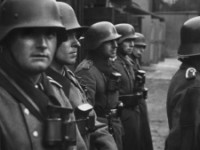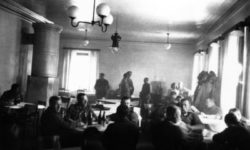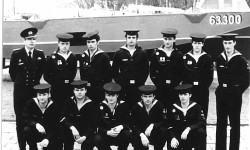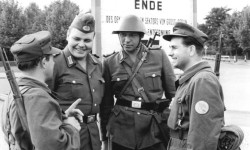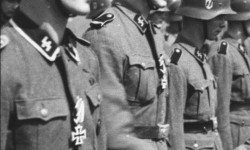The ranks of the armed forces were divided after the restructuring as in most modern armed forces into 3 careers. The partitioning was transferred thereby also to the entire armed services (army, Air Force, navy).
As a result of this restructuring the afterwards following careers arose:
- Mannschaften (Crews)
- Unteroffiziere (sergeants)
- Offiziere (officers)
Crews (Mannschaften)
People liable for military service crews carried the lowest in each case badges of rank of the armed service or branch of service concerned, as for example soldier, for the summoning from the time to the military service as far as the end of the basic training and led the utility position designation recruit.
University forming: Crews carried grey and/or dark-green shoulder straps with the number of the regiment or an appropriate federation with a Paspelierung in the weapon color without badges of rank. The badges of rank were carried at the left upper sleeve as Aufnäher. Beyond that crews carried collar mirrors in the weapon colors.
- Soldat (Soldier): Without sleeve-onnear; depending upon branch of service or branch of service designation (contactor, Kanonier, rider, pioneer, infantryman
, radio operator) would separate
- Obersoldat (upper soldier): A grey square star; depending upon branch of service or branch of service would separate designation (upper contactor, Oberkanonier, upper rider, upper pioneer, upper infantryman, upper radio operator)
- Gefreiter (Private first classes): A grey angle
- Obergefreiter (upper private first classes): Two grey into one another-pushed angles
- Obergefreiter mehr als sechs Dienstjahre (upper private first classes more than six service years): A grey angle, over it a grey star
- Stabsgefreiter (staff private first classes): Two grey into one another-pushed angles, over it a grey star
shoulder sleeve insignia: Stabsgefreiter (Staff private first class)(18), Obergefreiter (Upper private first class)(mehr als 6 Dienstjahre) (19), Obergefreiter (Upper private first class)(20), Gefreiter (Private first class )(21), Oberschütze (Upper contactor)(22)
Shoulder straps: A, B und C Stabsgefreiter (Staff private first class) bis Soldat (Soldier); C = Belonging one of the regiment "Großdeutschland"
NCOs without Portepee
NCOs carried their badges on shoulder straps, as matte-silver Tresse as edge. Their collar mirrors corresponded to those of the crews. Additionally the collars of the uniform skirts were occupied with a silver Tresse. Numbers of the regiments or abbreviations of the special uses were carried as aluminum on plugs.
- Unteroffizier (non-commissioned officer): (Mountain troops: Upper hunter): U-shaped Tresse
- Unterfeldwebel (Under sergeant): (Artillery and cavalry: under constable): Tresse approximately around the shoulder strap
The field blouse of an NCO of the division “large Germany”. At the right lower arm the pertinent sleeve volume in Sütterlinschrift and the devoured “GD” on the shoulder straps. The EK 2 in the button hole is was put on still in such a way, like it lent, only after approximately. one day the cross was put down and the volume was sewn on. Over the left breast pocket the field clip the winter medal “winter battle in the east”, on the breast pocket the infantry storm badge and the wounding badge in gold.
NCOs with Portepee
- Feldwebel (Sergeants): (Artillery and cavalry: constable): like Under sergeant, but additionally a four-jagged matte-silver aluminum star
- Oberfeldwebel (Staff sergeant) (artillery and cavalry: Upper being awake master): like Under sergeant, but two stars
- Stabsfeldwebel (Warrant officer) (artillery and cavalry: Staff being awake master): (Rank 1939 introduced to the three branches of service): like
Under sergeant, but three stars
Stabsfeldwebel (Warrant officer)(13), Oberfeldwebel (Staff sergeant )(14), Feldwebel (Sergeant)(15), Unterfeldwebel (Under sergeant)(16), Unteroffizier (non-commissioned officer)(17)
Field blouse of a technical sergeant of the armor branch in the Africa corps. Here the black tank jackets were not carried, since these would have been too warm. At the right lower arm the sleeve volume “Africa corps”, in the button hole the volume of the iron cross 2. Class. On the left breast pocket the iron cross 1. Class.
Officer candidate in the NCO rank (Offiziersanwärter im Unteroffiziersrang)
- Fahnenjunker-Unteroffizier (Officer cadet senior grade noncommissioned officer): like NCO, crosswise to it a double Noncommissioned officer tresse over the lower end of the shoulder strap
- Fähnrich (Sergeant): like Under sergeant, crosswise to it a double Unteroffiziertresse over the lower end of the shoulder strap
- Fahnenjunker-Feldwebel (Officer cadet senior grade sergeant) and/or. like sergeants: crosswise to it a double Noncommissioned officer tresse over the lower end of the shoulder strap
- Oberfähnrich (Upper officer cadet): like technical sergeants, crosswise to it a double Noncommissioned officer tresse over the lower end of the shoulder strap; in addition Upper officer cadet carried brown ouple things as well as the collar mirrors and the garrison cap (with silver cord) of the officers
- Unterarzt (Under doctor): Officer uniform with brown officer ouple things, officer garrison cap with silver cord as well as officer collar mirror. The shoulder straps however corresponded to those of a technical sergeant (thus no double Noncommissioned officer tresse as with the OAU of the troop service), however with a Äskulapstab between both stars
Fortress foreman and hoof fitting instructor
The fortress foremen and hoof fitting instructor formed their own rank class above the NCOs with Portepee.
Officers (Offiziere)
Traditionally German officers carried shoulder pieces with document in the weapon color. The shoulder pieces were from Aluminiumgespinst, at second lieutenants and main people cords (flat cords), sewn next to each other, with staff officers fivefold twisted, with generals quadruple, however somewhat more thickly than with the staff officer and from golden Gespinst with aluminiumfarbener insert twisted. In addition became if necessary. four-jagged golden or silver stars carried. The officer collar mirrors were attached, somewhat larger at the high-closed anthrazitfarbenen collar and silver with raids in the colors of the branch of service. The regiment number or special use abbreviations was carried as silver or golden aluminum on plugs.
- Leutnant (second lieutenant): no star (Lt.)
- Oberleutnant (first lieutenant): one golden star (OLt.)
- Hauptmann, Kavallerie: Rittmeister (Captain, cavalry: Ride master): two golden star
- Major (Major): no star
- Oberstleutnant (lieutenant colonel): one golden star
- Oberst (colonel): two golden star
Oberst (Colonel)(7) Oberstleutnant (Lieutenant colonel), here Oberfeldveterinär (Upper field veterinarian)(8) Major (Major)(9) Hauptmann (Captain)(10) Oberleutnant (First lieutenant)(11) Leutnant (Second lieutenant)(12)
Generals (Generäle)
- Generalmajor (major general): no star
- Generalleutnant (lieutenant general): one silver star
- General (mit dem Zusatz der Waffengattung) (General (with the addition of the weapon type) Army: two silver star
General of - artillery, - mountain troop, - infantry, - cavalry, - news troop, - cavalry, - pioneers
- Generaloberst (Senior general): three silver star
- Generalfeldmarschall (Field marshal): Two crossed silver marshal staffs
1 Generalfeldmarschall (Field marshal)(since 1942), 2 Generalfeldmarschall (Field marshal)(to 1942), 3 Generaloberst (Senior general), 4 General (general)(with additive of the branch of service), 5 Generalleutnant (lieutenant general) und 6 Generalmajor (major general)
Badge of rank at special clothing (Rangabzeichen an Spezialbekleidung)
Starting from the year 1942 for armed forces (army) and weapon SS badges of rank for the special clothing, employment clothing or special clothing were introduced. The appropriate Insignie was more sleeve on near carried as sleeve badges or.
1 Unteroffizier (non-commissioned officer), 2 Unterfeldwebel (under sergeant), 3 Feldwebel (sergeant), 4 Oberfeldwebel (Staff sergeant), 5 Stabsfeldwebel (Warrant officer), 6 Leutnant (second lieutenant), 7 Oberleutnant (first lieutenant), 8 Hauptmann (captain), 9 Major (major), 10 Oberstleutnant (lieutenant colonel), 11 Oberst (colonel), 12 Generalmajor (major general), 13 Generalleutnant (lieutenant general), 14 General der Waffengattung (general of the branch of service) 15 Generaloberst (colonel general), 16 Generalfeldmarschall (general field marshal)
You can find the right literature here:
The Wehrmacht: The Growth and Organisation of German Land Forces

The Wehrmacht: The Growth and Organisation of German Land Forces (WWII Germany) Paperback – January 1, 2018
The Wehrmacht (meaning ‘defensive might’) encompassed the entire German armed forces during World War II. Rising from the ashes of the post-World War I Reichswehr in 1935, the Wehrmacht became one of the cornerstones of Hitler’s re- assertion of German military might. More than 18 million men passed through the ranks of the Wehrmacht over of the 10 years of its existence. World War II Germany: The Wehrmacht focuses on the German land forces, with chapters on the history of the German Army, pre-war development, command structures, infantry, armoured formations, artillery and support services. The book offers interesting facts and figures of every sort, from infantry tactical doctrine through the make-up of a Type 1944 infantry division to the number of operational panzers Rommel had at his disposal during the El Alamein campaign and the types of artillery employed in the Atlantic Wall fortifications before the D-Day landings. The book includes color artworks of key equipment and weapons, reference tables, diagrams, maps and charts, presenting all the core data in easy-to-follow formats. Packed with hundreds of helpful illustrations, World War II Germany: The Wehrmacht offers military history enthusiasts key data on every aspect of Germany’s ground forces during World War II.
The Wehrmacht: History, Myth, Reality
This book is a profound reexamination of the role of the German army, the Wehrmacht, in World War II. Until very recently, the standard story avowed that the ordinary German soldier in World War II was a good soldier, distinct from Hitler's rapacious SS troops, and not an accomplice to the massacres of civilians. Wolfram Wette, a preeminent German military historian, explodes the myth of a "clean" Wehrmacht with devastating clarity.
This book reveals the Wehrmacht's long-standing prejudices against Jews, Slavs, and Bolsheviks, beliefs that predated the prophecies of Mein Kampf and the paranoia of National Socialism. Though the sixteen-million-member German army is often portrayed as a victim of Nazi mania, we come to see that from 1941 to 1944 these soldiers were thoroughly involved in the horrific cleansing of Russia and Eastern Europe. Wette compellingly documents Germany's long-term preparation of its army for a race war deemed necessary to safeguard the country's future; World War II was merely the fulfillment of these plans, on a previously unimaginable scale.
This sober indictment of millions of German soldiers reaches beyond the Wehrmacht's complicity to examine how German academics and ordinary citizens avoided confronting this difficult truth at war's end. Wette shows how atrocities against Jews and others were concealed and sanitized, and history rewritten. Only recently has the German public undertaken a reevaluation of this respected national institution--a painful but necessary process if we are to truly comprehend how the Holocaust was carried out and how we have come to understand it.
Wehrmacht Panzer Divisions 1939-45
Illustrated with detailed artworks of German tanks and their markings with exhaustive captions and specifications, The Essential Tank Identification Guide: Wehrmacht Panzer Divisions 1939–45 is the definitive study of the equipment and organization of the Wehrmacht’s armoured divisions. Organized by division, the book describes in depth the various models of tank in German service during the war with each individual armoured division, with listing of the unit commanders and any famous tank aces. Each divisional section is further broken down by campaign, accompanied by orders of battle, a brief divisional history of the campaign and any specific unit markings. With information boxes accompanying the full-color artworks, all drawn to the same scale, The Essential Tank Identification Guide: Wehrmacht Panzer Divisions 1939–45 is an essential reference guide for modellers and any enthusiast with an interest in the armoured divisions of the German Wehrmacht.
Hitler's Wehrmacht, 1935–1945
Since the end of World War II, Germans have struggled with the legacy of the Wehrmacht―the unified armed forces mobilized by Adolf Hitler in 1935 to ensure the domination of the Third Reich in perpetuity. Historians have vigorously debated whether the Wehrmacht's atrocities represented a break with the past or a continuation of Germany's military traditions. Now available for the first time in English, this meticulously researched yet accessible overview by eminent historian Rolf-Dieter Müller provides the most comprehensive analysis of the organization to date, illuminating its role in a complex, horrific era.
Müller examines the Wehrmacht's leadership principles, organization, equipment, and training, as well as the front-line experiences of soldiers, airmen, Waffen SS, foreign legionnaires, and volunteers. He skillfully demonstrates how state-directed propaganda and terror influenced the extent to which the militarized Volksgemeinschaft (national community) was transformed under the pressure of total mobilization. Finally, he evaluates the army's conduct of the war, from blitzkrieg to the final surrender and charges of war crimes. Brief acts of resistance, such as an officers' "rebellion of conscience" in July 1944, embody the repressed, principled humanity of Germany's soldiers, but ultimately, Müller concludes, the Wehrmacht became the "steel guarantor" of the criminal Nazi regime.
The Wehrmacht's Last Stand: The German Campaigns of 1944-1945

The Wehrmacht's Last Stand: The German Campaigns of 1944-1945 (Modern War Studies) Hardcover – November 6, 2017
By 1943, the war was lost, and most German officers knew it. Three quarters of a century later, the question persists: What kept the German army going in an increasingly hopeless situation? Where some historians have found explanations in the power of Hitler or the role of ideology, Robert M. Citino, the world’s leading scholar on the subject, posits a more straightforward solution: Bewegungskrieg, the way of war cultivated by the Germans over the course of history. In this gripping account of German military campaigns during the final phase of World War II, Citino charts the inevitable path by which Bewegungskrieg, or a “war of movement,” inexorably led to Nazi Germany’s defeat.
The Wehrmacht’s Last Stand analyzes the German Totenritt, or “death ride,” from January 1944—with simultaneous Allied offensives at Anzio and Ukraine—until May 1945, the collapse of the Wehrmacht in the field, and the Soviet storming of Berlin. In clear and compelling prose, and bringing extensive reading of the German-language literature to bear, Citino focuses on the German view of these campaigns. Often very different from the Allied perspective, this approach allows for a more nuanced and far-reaching understanding of the last battles of the Wehrmacht than any now available. With Citino’s previous volumes, Death of the Wehrmacht and The Wehrmacht Retreats, The Wehrmacht’s Last Standcompletes a uniquely comprehensive picture of the German army’s strategy, operations, and performance against the Allies in World War II.
This post is also available in:
 Deutsch (German)
Deutsch (German)  Français (French)
Français (French)  Italiano (Italian)
Italiano (Italian)  简体中文 (Chinese (Simplified))
简体中文 (Chinese (Simplified))  Русский (Russian)
Русский (Russian)  Español (Spanish)
Español (Spanish)  العربية (Arabic)
العربية (Arabic)

